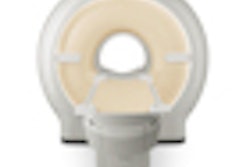MR elastrography measures the properties of tissues through low frequency waves that induce stress, and is proving an effective way to distinguish between malignant and benign liver tumors, French researchers have found in a study published online in European Radiology.
The team, from the University Paris Diderot in Sorbonne Paris, now thinks the modality can be used to evaluate the shear properties of the tissues.
"Shear properties are best described as a complex number, the shear modulus," they wrote. "Its real part is the storage modulus, which is determined by the restoration of mechanical energy owing to the elastic properties of the material, whereas the imaginary part is the loss modulus and is associated with viscous properties given mostly by the tissue-inherent mechanical friction."
By calculating the storage modulus and loss modulus, lead study author Dr. Philippe Garteiser and colleagues from the university's department of radiology were able to determine the characteristics of liver tumors through MR elastography. Their article was published on 10 May.
As previous research has shown, MRI is a beneficial tool in determining liver tumor characteristics by examining morphological features through techniques such as signal intensity on T1-, T2-, and diffusion-weighted images. In addition, liver-specific contrast agents and evaluating enhancement patterns during late retention phases can enhance the characteristics of certain tumors, including hepatocellular tumors.
However, because tumor characterization still may depend on information gathered from a liver biopsy, there remains the need for effective noninvasive ways to diagnose liver tumors.
The prospective study evaluated consecutive adult patients who underwent MRI exams to assess liver tumors between January 2009 and June 2010. MRI scans were performed on a 1.5-tesla clinical system (Intera, Philips Healthcare) equipped with a four-element surface coil array.
Researchers included patients with an indication of one or more solid liver tumors larger than 1 cm in diameter and a proven diagnosis. Prospective subjects were excluded if they had been received cancer therapy, had cystic lesions, or no definitive histological diagnosis of liver cancer.
The final study population included 72 patients. They were 27 men with an average age of 59 years (ranging from 20 to 78 years) and 45 women with an average age of 46 years (ranging from 20 to 70 years). Researchers studied a total of 37 malignant lesions and 35 benign lesions. Tumor diagnoses were made through either histopathological analyses of liver biopsies and surgical specimens, or through imaging and follow-up.
MRI protocol
Researchers first obtained unenhanced transverse MR images of the entire liver through fat-suppressed and nonfat-suppressed T2-weighted fast spin echo images, T1-weighted gradient-echo images, and diffusion-weighted images. The second round of imaging included MR elastography on the largest tumor seen on the unenhanced MR images.
A third round of MR imaging used 3D gradient-echo, T1-weighted transverse images of the liver prior to contrast injection and during the arterial, portal venous, and delayed phases after bolus injection of 0.1 mmol per kg gadoterate dimeglumine (Dotarem, Guerbet).
Upon review of the MRI results, researchers found that the magnitude of the shear modulus of malignant lesions (3.38±0.26 kPa) was significantly higher than that of benign lesions (2.41±0.15 kPa, P<0.01). Malignant tumors also displayed a "markedly higher" loss modulus (2.25 + 0.26 kPa) compared to benign lesions (1.05 + 0.13 kPa).
When examining the viscoelastic components individually, the storage modulus was somewhat higher in malignant tumors (2.37±0.15 kPa) than benign tumors (2.37±0.15 kPa), but this difference was not statistically significant.
"Best discriminator"
"Loss modulus was the best discriminator between benign and malignant tumors and the only biomechanical parameter that differed between individual tumor types," the authors wrote. "This suggests that measuring the loss modulus may be helpful for liver tumor characterization."
Garteiser and colleagues recommended additional studies in specific patient populations. "As [loss modulus] of malignant hepatocellular tumors was significantly higher than that of benign hepatocellular lesions in this study," they noted, "It may be interesting to further assess the potential role of MR elastography with [loss modulus] measurements in patients having nodular hepatocellular lesions in cirrhosis."
The authors also cited several limitations to the study, which included a small sample of certain tumor types, adding that larger prospective studies would be required to confirm this study's results.
In addition, researchers noted that MR elastography requires separate breath holds, which depend on the ability of patients to maintain a constant abdominal position. "We are currently working on acquisition methods with increased speed, which may result in fewer breath holds to alleviate this problem and improve patient comfort," the authors wrote.



















